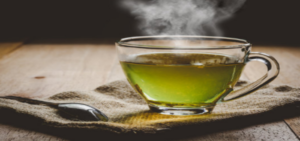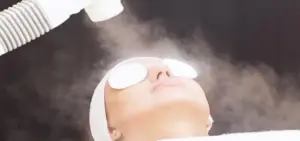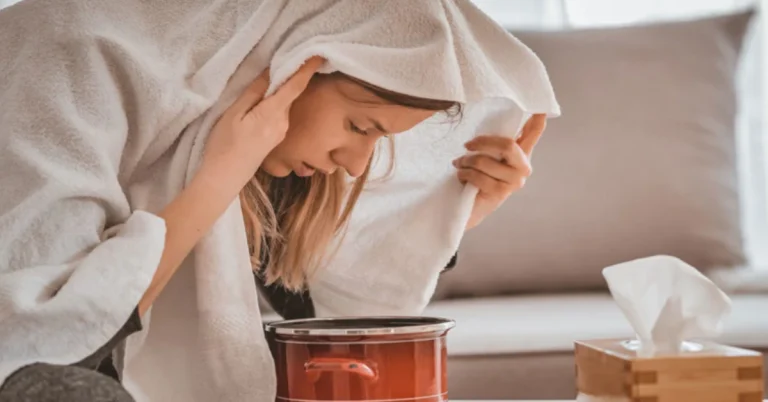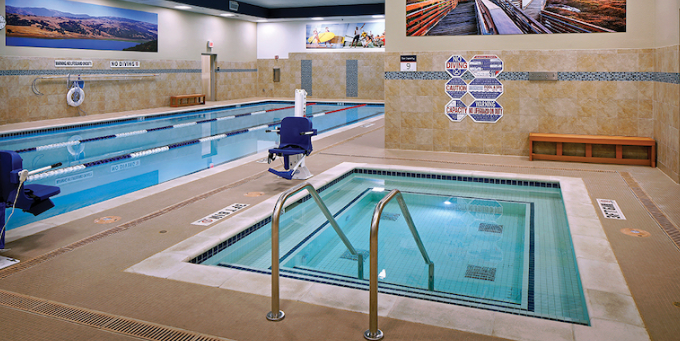Our sunasusa research team found that the benefits of face steaming can help in pore opening, allowing more thorough cleaning and better skincare product absorption. The steam can improve circulation, which will result in skin that seems healthy and radiant. To hydrate and wash their skin, people use a variety of techniques.
Some people use face steaming and water vapor, while others search for the best cleansers and moisturizers for their faces. A simple bowl or a pan of boiling water will do, but for added health benefits, some people like to add oils, dried herbs, tea, lemon, and salt. The benefits of face steaming have not been fully researched by scientists, and the majority of the material that is now obtainable depends on personal experience.
Table of Contents
What Is Face Steaming and How Does It Operate?

Heating your face to warm, humid air typically created by boiling water or specialized equipment is known as face steaming. To enjoy the added benefits start with a clean face and add herbs or fragrant oils to the steaming water. Place a towel over your head to collect and direct the steam towards your face while you position yourself over the steam.
Hold this position for 5 to 10 minutes. To improve the absorption of your skincare products, carefully dry your face after steaming. The steam opens pores, softens the skin’s surface, and encourages sweating. Simpler skin is the result of this process, which allows pollutants like oil and dirt to escape.
The skin receives more nutrients and oxygen because of the increased circulation caused by the steam, which leaves the skin appearing more refreshed and healthy. Ancient cultures like the Romans and Greeks recognized the benefits of face steaming, and it is still a common procedure in spas today for professional treatments.
Essentials of Face Steaming
Warm steam applied to the face promotes pore opening, softens dead skin cells, and increases blood flow. This procedure gets your skin ready for more thorough cleaning, treatment applications, and improved skincare product absorption, all of which lead to a complexion that is healthier and more beautiful.
Enhanced with Organic Substances

- Lemon: Adding lemon to your face steaming gives you a boost of vitamin C and citric acid, which are well-known for brightening and anti-aging the skin. Lemon may lighten dark spots, even out skin tone, and make your skin look more radiant. Lemon should be used carefully though, as it might irritate some skin types, especially when exposed to sunlight.
- Green Tea: By adding green tea to your face steam, you can introduce antioxidants like phenol and catechins. The anti-inflammatory, wrinkle reduction, and skin-soothing properties of these substances are well established. In addition to preventing acne-causing germs and redness, green tea shields the skin from the elements, giving the appearance of younger, healthier skin.
- Saltwater: Adding saltwater to your steam has antibacterial and anti-allergic natural features, which makes it perfect for oily or acne-prone skin. It relieves inflammation, minimizes the appearance of acne, and thoroughly cleans pores. Moreover, steaming with saltwater regulates oil production for a clear complexion.
Benefits of face steaming
The following are a few possible health benefits of face steaming:
Better Circulation
The warmth of the steam draws blood to the face, where it carries more nutrients and oxygen for the skin. This increase in circulation can support the skin’s natural healing processes and help a healthy, radiant complexion.
Deep Cleaning
Steaming your face opens up the pores, which facilitates the removal of debris, oil, and other pollutants that can cause blackheads and acne. Deep cleaning keeps the skin fresh and healthy while reducing the chance of epidemics.
Relaxes Skin Disorders
Steaming the face can help reduce some skin disorders, such as psoriasis or eczema. A more pleasant and less disturbed complexion can result from the moisture and heat’s ability to soothe inflamed skin and reduce inflammation.
Opens Nostrils
Steaming has the added benefit of opening the sinuses and nasal passages, which helps with respiratory problems. This may help reduce headaches, pressure in the nasal passages, and other symptoms associated with the nose.
Detoxification
Steaming helps in the removal of toxins from the skin that may be the cause of dullness and skin damage. Sweating is encouraged by the technique, which aids in pore cleaning and the removal of pollutants.
Rehydrate Your Skin
The use of face steamers to hydrate dry skin is not particularly suggested by the American Academy of Dermatology (AAD). But for those who have dry skin, they advise closing a bathroom door while taking a bath or shower to capture steam, which hydrates the skin. While they advise against taking hot baths or showers since they may worsen dry skin, they do support utilizing a humidifier to hydrate the air.
Boost Cosmetics’ Effectiveness
By exposing the skin to hot water vapor, facial steaming increases skin temperature and enhances blood flow. Improved circulation can help skincare products enter better. Absorption of smoke increased thrice at higher temperatures, indicating that creams, lotions, and masks may be more effectively absorbed by warmer skin. The clinical benefits of using skincare products on heated skin are still unknown.
Offer a Calming Feeling
Using face steamers is said to make many people feel at ease and relaxed. Stress-relieving steam rooms are common in gyms and spas, and people from all over the world travel to natural hot springs to unwind. Many spas try to resemble the peaceful surroundings of hot springs, given a lack of scientific data on their health benefits.
Clear the Pores
Hot steam is believed to open pores and help in dirt removal, which is why many use face steamers. The American Academy of Dermatology (AAD) recommends avoiding items that may block pores and using gentle cleansers twice daily as an alternative to using face steamers to open up pores. Although pore size isn’t affected by changes in temperature, connected pores may look larger. Although retinol products might help with pore appearance, it’s best to speak with a doctor before using them.
Increase the Production of Collagen
Certain commercial face steamers assert to increase the creation of collagen and elastin, two essential proteins for maintaining the volume and flexibility of the skin. Skin can become thinner and looser as we age due to a reduction in collagen and elastin. The idea that heating increases the amounts of collagen and elastin is not supported by scientific research.
Disadvantages of steaming face
The benefits of face steaming have already been discussed. Steam burns are an issue with face steaming, no matter how it’s done. A scald is a kind of burn brought on by hot liquids or steam. When skin comes into touch with heated steam, burns may result.
These burns can happen at home when heating your face, even though they are frequently observed in restaurant employees. Using open containers and letting the water cool for a minute or two before opening will help prevent the steam from heated liquids reaching temperatures as high as 200°F when heating water in a microwave.
It is not recommended for people to steam their faces if they have acne, eczema, or other aggressive skin illnesses like psoriasis. The blood vessels can expand due to the heat, which might increase redness and inflammation. Before beginning face steaming, people should find out if this treatment is appropriate for their skin type by speaking with a physician or specialist.
Various Methods to Try

Facial steaming can be done at home in a variety of ways, from inexpensive and easy to more complex. Here is a detailed how-to for every method:
Warm Towels for Steaming
To use warm towels for steaming:
- Use hot water from the pump to wet a hand towel. Once heated, pour enough water into a bowl or sink to soak up the towel.
- To the water, add any preferred herbs.
- Keep your hair out of your face and use a light exfoliant cleanser to clean your face and neck.
- After soaking the towel in the hot water, wring it out to make it somewhat damp.
- Sit back in a comfortable chair or take a break. Gather the towel’s edges at your forehead and wrap it over your face.
- Make sure the towel covers every part of your face, including your eyes, so that just your nose is visible. Spend around five minutes relaxing.
Commercial Steamers for Faces
Although individuals can purchase a variety of commercial face steamers at different price points, there is no scientific proof of their efficacy. Several functions and attachments for treating pimples and pores are frequently included with these devices.
On the other hand, improper face-cleaning instruments and equipment may cause infections and damage to the skin. For facial care, the AAD suggests utilizing mild techniques. They advise using gentle cleansers, avoiding harsh scrubbing, and patting the skin dry with a fresh towel to treat acne.
Spa Services
Spa services can be highly costly; certain spas provide extensive facial packages that span several visits. Numerous procedures, including mud applications, exfoliation, massages, masks, and heating, may be included in these facials. It’s challenging for studies to evaluate specific benefits of spa treatments or contrast them with over-the-counter face steamers because spa offers differ.
Steaming Hot Water in a Bowl
Steaming your face with everyday kitchen or bathroom tools is a substitute for buying a steamer. To prevent burns, use caution when using this procedure, which includes boiling water to create steam. A cloth may be placed over the head of the steamer to concentrate the steam, and some individuals like to wash their faces before steaming.
It’s crucial to watch how long you steam because too much steam might cause skin dryness. After steaming, people frequently use face creams or other cosmetics. There is no scientific proof that adding ingredients like salt, lemon, green tea, herbs, or essential oils to the steaming water is safe or effective, but some people still do it.
Although green tea is well-known for having antioxidants, no proof steaming it imparts these qualities to the skin. Only a small number of research have suggested that applying green tea extract and tea tree oil topically—not in vapor form—may help with acne. To determine whether adding other compounds to the water boosts the benefits of face steaming and how successful it is, more research is required.
Methods for Preparing for Face Steaming

1. Preparation
- Hydrate: Drink water before steaming to keep your body properly hydrated—heat can cause dehydration.
- Wash: To make sure your skin is clean and ready to absorb the benefits of face steaming, wash it with a mild cleanser and an exfoliant.
2. At the Steam
- Keep Your Eyes Closed: This will help you feel more at ease and shield your eyes from possible irritation. It permits the steam to also be helpful for the eyes.
- Preserve Distance: To protect your face from burns, keep it 6 to 10 inches away from the sink or bowl. Consider how your skin feels and change the distance to a comfortable distance.
- Observe directions: For secure and effective use, read carefully and follow the manufacturer’s directions if you’re using a skin-care steamer.
3. Right After
- Wash and Wipe Dry: Wash with warm water and pat dry carefully with a clean towel because your skin will be more vulnerable to irritation.
- Apply a Moisturiser: Your skin will absorb a moisturizer more readily after steaming. If you want to seem younger, use an anti-aging lotion and use a nourishing product.
- Massage Your Face: Give your face a light massage after steaming. To massage the top of your head, cheeks, and neck, use upward strokes. You can add a small amount of face oil to your massage if your skin isn’t too sensitive or oily.
How to Select the Ideal Steaming Base for Your Face
While plain water is widely available and works well for most skin types, it is the best base for face steaming. To lower the possibility of pollutants, it is preferable to choose spring or bottled water over common water because they offer a neutral base that is suitable for sensitive skin.
Take care not to oversteam, use only warm water to avoid irritating skin, and make sure the water is pure and clear of impurities. It’s crucial to be mindful of any possible sensitivities or allergies before adding items like lemon, sea, or green tea. You may improve your steaming experience by patch-testing new components and getting professional advice for specific skin issues.
Conclusion
In conclusion, there are several possible benefits of face steaming, including pore cleaning, skin hydration, and relaxation. However, they aren’t supported by any scientific data. Spa treatments and commercial face steamers are available, although they might not make a big difference in the appearance of skin. Face steaming is not likely to be risky if done properly and carefully. But using really hot vapor can result in steam burns.







